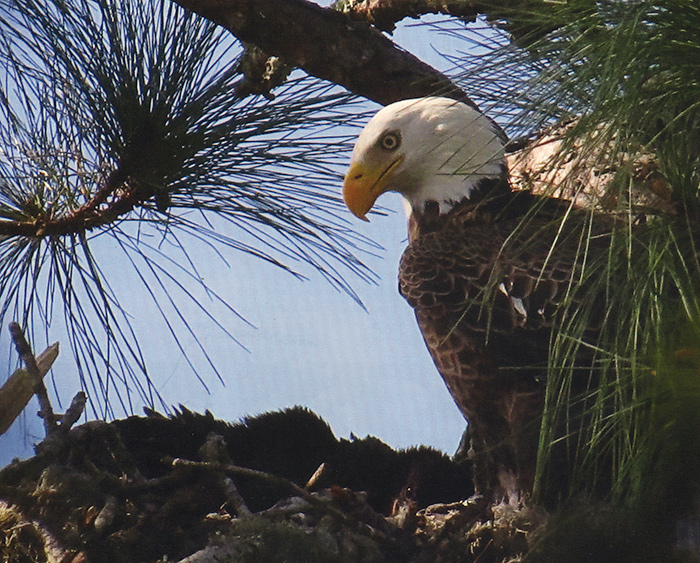Lead Toxicity in Bald Eagles
Over the past twenty-five years, lead toxicity—or lead poisoning—has become an increasingly apparent concern impacting bald eagles along with other bird species and wildlife.
A recent study revealed that 47% of bald eagles and 46% of golden eagles had signs of chronic lead poisoning, which is the result of repeated lead exposure. As many as 33-35% of eagles had acute lead poisoning from exposure to high lead levels. These statistics came from samples taken across 38 states over the course of eight years (Slabe et. al, 2022).
These numbers nearly double the previous years’ reports from the University of Minnesota’s Raptor Center, which indicated that over a quarter of sick or ill eagles treated had lead toxicity (The Raptor Center).
The increasing lead levels in rehabilitation eagles’ blood suggests that lead toxicity is tangibly impacting the health of bald eagle populations.
What are the symptoms of lead toxicity?
A lead fragment the size of a grain of rice is lethal to a mature bald eagle, meaning that a standard 150 grain lead bullet can poison 10 eagles. The deadly metal accumulates in an eagle’s system over the course of their lives, meaning that there is no safe amount of lead exposure. For this reason, lead is often called “the silent killer.”
Even a small exposure to lead can cause devastating illness in eagles. Common symptoms include brain swelling, respiratory distress, muscle weakness, dehydration, starvation, kidney and liver damage, and seizures. Associated neurological damage can result in loss of vision, coordination, and nerve function; the bird may appear “drunk” or be unable to stand. The feces often turn a vibrant, sickening green.
For most eagles with acute poisoning, the prognosis is not good. For those with non-lethal exposures (aka “subclinical levels), treatment is a long, grueling process that often costs thousands of dollars. Even after weeks of injectable and oral chelation therapy, the neurological side effects of lead may be permanent and result in the bird being deemed non-releasable (Joseph 2013).
How can outdoorspeople help?
Sportsmen and sportswomen have a longstanding history of championing conservation, both through protecting habitats and wildlife management. A recent survey by Ducks Unlimited suggests that hunters are more than three times as likely as nonhunters to participate in organized wildlife conservation efforts (Young).
The research on lead toxicosis in bald eagles indicates that these exposures are unintended consequences from lead ammunition fragments and lead fishing tackle that are left behind in the field (Buehler 2020).
Because these exposures are accidental, such as when a fish breaks the line or when a gut pile is left behind, the best way to decrease the risk of lead exposure is to transition to non-lead ammunition and tackle.

Education around this issue is imperative not just for the health of bald eagles but also humans. Lead fragments from ammunition spread far beyond the wound channel. This means that fragments may exist in gut piles left behind in the field, and it also poses a risk to meat processed for human consumption. A study using 324 randomly selected venison packages from processors found that 34% contained as much as 150 separate lead fragments (Hunt et al., 2009).
As the bald eagle taught us, conservation can be a powerfully unifying force, and we call on our fellow conservationists and outdoorspeople to preserve the biodiversity and natural beauty of this country.
Resources
Buehler, D.A. (2020). Bald eagle (Haliaeetus leucocephalus). Birds of the World. Cornell Lab of Ornithology, Ithica, NY, USA. https://doi.org/10.2173/bow.baleag.01
Hunt, W.G., Watson, R.T., Oaks, J.L., Parish, C.N., Burnham, K.K., Tucker, R.L., Belthoff, J.R., & Hart G. (2009) Lead bullet fragments in venison from rifle-killed deer: potential for human dietary exposure. PLoS ONE 4(4), https://doi.org/10.1371/journal.pone.0005330
Joseph, V. (2013) Lead Toxicity in Wild Birds: A Case for Requiring Non-Lead Ammunition. Humane Society Veterinary Medical Association. https://www.hsvma.org/lead_toxicity_in_wild_birds
Slabe, V.A., Anderson, J.T., Millsap, B.A., Cooper J.L., Harmata A.R., Restani M., Crandall R.H., Bodenstein, B., Bloom P.H.,& Katzner, T.E. (2022). Demographic implications of lead poisoning for eagles across North America. Science, 375 (6582), https://doi.org/10.1126/science.abj3068
The Raptor Center. Our Research: Lead Poisoning. https://raptor.umn.edu/about-us/our-research/lead-poisoning
Young, M. Hunters and anglers are North America’s greatest conservationists. Ducks Unlimited. https://www.ducks.org/conservation/national/sportsmen-conservation#:~:text=By%20purchasing%20and%20leasing%20land,wildlife%2Dfriendly%20manner%20as%20well.

